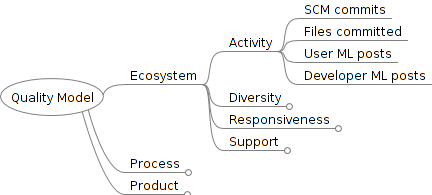The Alambic quality model
One of the first things to setup when considering to use Alambic is the quality model.
In a nutshell, the quality model states what is important to you (your definition of quality, in this very context) and how to measure it. It makes the link between the quality attributes and the metrics gathered or computed by Alambic.
Note See the definition of quality attributes, indicators, metrics and scales in the Terminology section.
Structure
The quality model is defined as a tree structure. The main quality attribute (at the root of the tree) is the main rating for the project (e.g. Project's Quality or Maturity). Each attribute is computed from its children, up to the leaves of the tree: the metrics retrieved or computed by Alambic.
As an example, let's say we want to check the activity of our ecosystem. We decide to measure it through a set of metrics retrieved from mailing lists, forums and configuration management (git):

When the project is analysed, metrics are populated, converted to indicators using scales, and aggregated up to the root of the quality model.
Aggregating values
So from top to bottom the chain looks like:
- Quality attribute Ecosystem is subdivided into:
- Quality attribute Activity which is measured through:
- Number of emails on the Dev ML (say during one week)
- Number of messages on the User forums (say during one week)
- Number of commits (say during one week)
- Number of committed files (say during one week)
- Quality attribute Diversity
- Quality attribute Responsiveness
- Quality attribute Activity which is measured through:
On the other hand from the bottom up measures are converted to indicators using a 4-thresholds scale. Indicators are then aggregated up from the leaves to the root of the quality model tree. As an example:
- Metric 'Number of commits' has value
56and a scale such as[5,10,50,100]=> Indicator 'Number of commits' has value 4 out of 5 - Metric 'Number of commmitted files' has value
13and a scale such as[5,10,50,100]=> Indicator 'Number of committed files' has value 3 out of 5 - Metric 'Number of emails' has value
24and a scale such as[5,10,25,50]=> Indicator 'Number of emails' has value 3 out of 5 - Metric 'Number of messages' has value
7and a scale such as[5,10,25,50]=> Indicator 'Number of messages' has value 2 out of 5
The Activity's value is the average of all its children, which is in this case 3 out of 5. Other attributes are computed the same way, and values are aggregated up to the root of the quality model.